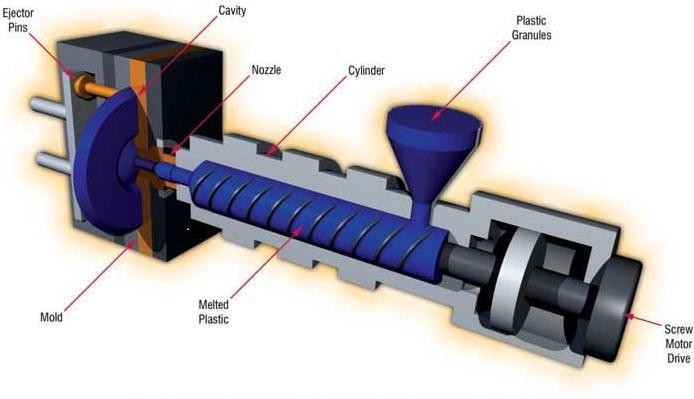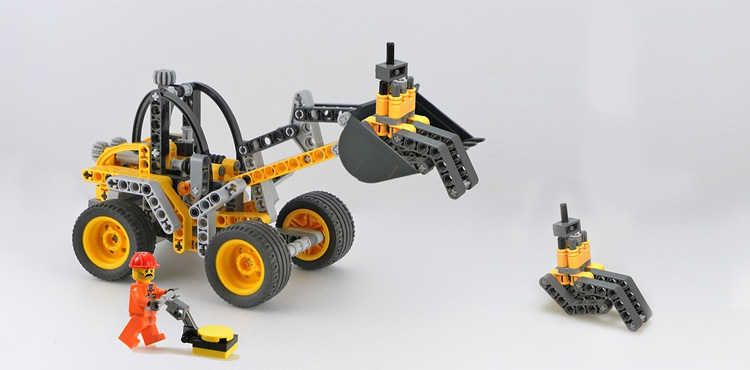A BRIEF OVERVIEW ON PLASTIC INJECTION MOLDING: USES, MACHINE TYPES & ADVANTAGES
Injection molding is the most universally used manufacturing process to produce plastic parts. A large variety of plastic goods that greatly vary in their size, complexity, and application are manufactured using injection molding. The injection molding course requires the utilization of an injection molding machine, raw plastic material, and a mold. The injection molding machine melts the plastic which is then injected into the mold. This molten plastic is then cooled and solidified to take the shape of the final product.
Uses of Injection Molding:

Injection molding is used to create thin-walled plastic elements for a large variety of applications. Its applications can be found in plastic housings. They could be a thin-walled enclosure, typically requiring several ribs and executives on the inside. These housings are used in a variety of products such as household appliances, consumer electronics, power tools, and automotive bumpers/dashboards. Injection molding is additionally used for manufacturing everyday products like toothbrushes, bottle caps or tiny plastic toys. Medical devices, such as valves and syringes, are also some of the products made from injection molding.
Types of Plastic Injection Molding Machines:

Different industries and applications require different machines. Simply put all types of injection molding machines are made up of two parts first an injection unit and second a clamping unit. Though it may appear simple they offer wide-ranging needs of the end-user. Listed below are some of the types.
1) Fully hydraulic machine: They provide high clamping force that’s required for large plastic part production.
2) Electrical machine: They are excellent for short injection times and supply the best production cleanliness.
3) Hybrid machine: They have excellent energy efficiency and supplies more freedom for innovative mold design.
Over the years, multiple machines have been designed to suit every application that has conferred itself within the injection molding industry.
Benefits of Plastic Injection Molding:
1) Plastic injection molding is a very versatile method of manufacturing parts and products. It is extremely simple, reliable, and an efficient method over other methods of plastic molding.
2) The injection molds are subjected to extremely high pressure which makes it possible to add a large amount of complex shapes and details into the design. These geometrical designs otherwise would have been too complicated to manufacture.
3) The plastic injection molding process takes less time which allows more parts to be manufactured from a single mold. The high production output rate makes plastic injection molding cost-effective and efficient.
4) One of the major advantages of using plastic injection molding is the use of co-injection molding which makes it possible to use different types of plastic.
5) Plastic injection molding is an automated process. It is carried out by robotics which acts as a sole operator to control and manage the process. This minimizes manufacturing costs, as the overheads are considerably reduced.
6) With abundant R & D into this space, plastic injection molding today is an environment-friendly process. The scrap plastic generated during the production process is reground and re-used, ensuring that the process generates very little waste.
If you are in the plastic injection molding business, then Plastivision is a great platform for you to showcase your product range and network with industry professionals. Book your booth today!
Leave a Reply Cancel reply
Recent Posts
- Understanding The Materials That Are Used To Build Plastic Toys
- All You Need To Know About Food-grade Plastics
- A Glance At The Materials That Boost The Performance Of Plastics
- Understanding The Importance Of Exploring New Business Opportunities In The Plastic Industry
- Understanding The Importance Of Investing in R&D For The Plastic Industry
Categories
- 3D Printing
- AIPMA
- Automation
- Automobile Sector
- Bio Plastics
- Environment
- Innovations In Recycling
- Latest Innovations
- Molds & Dies
- News
- Packaging Industry
- Plastic
- Plastic Application
- Plastic Industry
- Plastic Market
- Plastic Myths
- Plastic News From The World
- Plastic Packaging
- Plastic Products
- Plastic Recycling
- Plastic Solar Cells
- Plastic Toys
- Plastic Waste
- Plastic World
- Plastics
- Plastics And Their Applications
- Plastics In Agriculture
- Plastics In Healthcare
- Plastics In Medical Industry
- Plasticulture
- Processing Machinery
- Recycling Machines
- Robotics
- Uncategorized
- Virtual Reality
Archives
- November 2023 (3)
- October 2023 (2)
- September 2023 (3)
- August 2023 (3)
- July 2023 (3)
- June 2023 (3)
- May 2023 (2)
- April 2023 (2)
- March 2023 (2)
- February 2023 (2)
- January 2023 (2)
- December 2022 (3)
- November 2022 (1)
- October 2022 (1)
- September 2022 (2)
- August 2022 (1)
- July 2022 (3)
- May 2022 (3)
- March 2022 (2)
- February 2022 (1)
- January 2022 (1)
- September 2021 (2)
- August 2021 (3)
- July 2021 (4)
- June 2021 (4)
- May 2021 (3)
- April 2021 (2)
- March 2021 (4)
- November 2019 (8)
- October 2019 (8)
- September 2019 (8)
- August 2019 (8)
- July 2019 (8)
- June 2019 (8)
- May 2019 (8)
- April 2019 (8)
- March 2019 (8)
- February 2019 (11)
- January 2019 (8)
- December 2018 (8)
- November 2018 (12)
- October 2018 (12)

